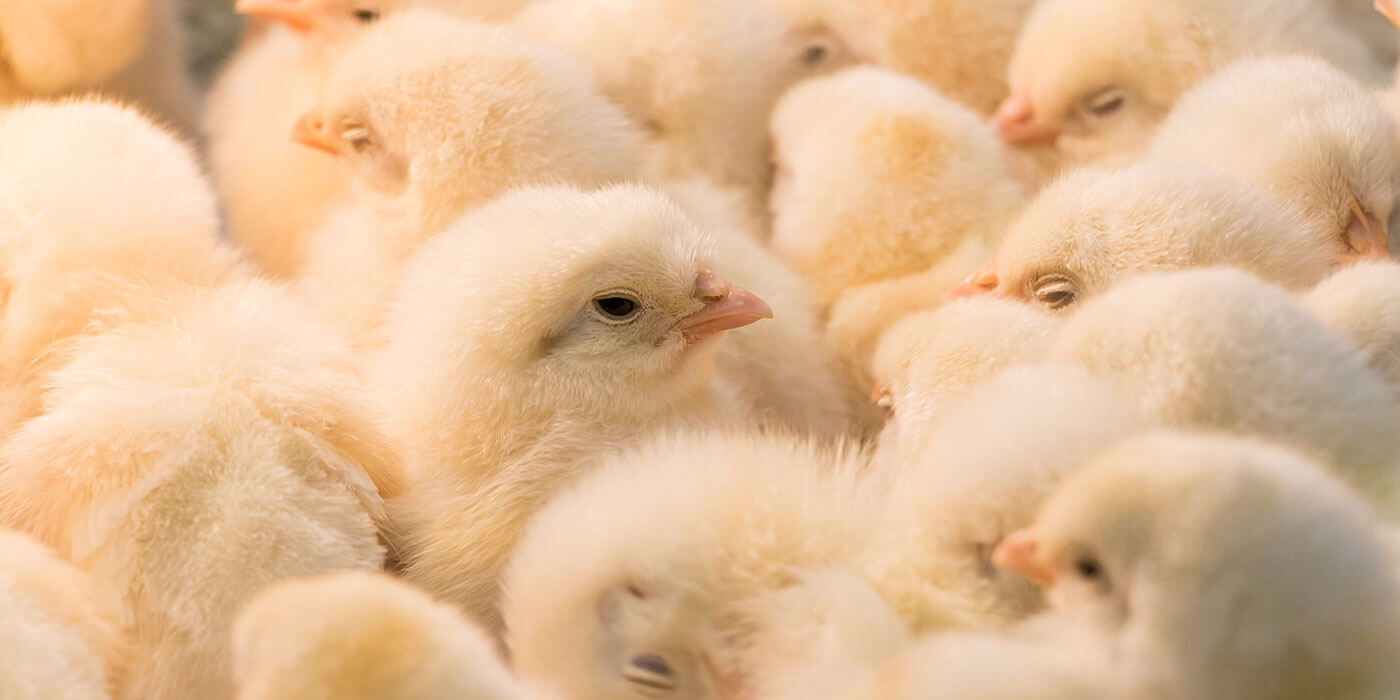Section 1 | An Overview of Necrotic Enteritis
Industry
Page 07 /
Environmental Factors
Nutrition
Protein
Dietary protein sources of animal origin (for instance fish meal, meat and bone meal, and feather meal) can predispose birds to NE, as can some plant proteins (e.g. soy protein concentrate)1. Much of this risk is driven by high glycine levels (a type of amino acid, or protein building block) in the feed1. Also, if crude dietary protein is too high, animals might also be at higher risk of NE1.
These proteins may:
- Provide high levels of nutrition that favours rapid C. perfringens growth
- Introduce damaging compounds to the gut
- Alter the protective gut microflora (out-compete the ‘good’ bacteria)
- Be contaminated with C. perfringens2

Source: Chicken Farmers of Canada
Fat
Dietary fat may also play a role in NE. Birds fed lard and tallow have higher C. perfringens levels relative to soy-oil fed animals1.
Carbohydrates
Highly digestible carbohydrates, such as glucose, starch, lactose, fructose, etc. can cause rapid C. perfringens growth and toxin production3. The theory is that high amounts of these carbohydrates overwhelm the ability of the bird’s digestive tract to digest and absorb them — more of these carbohydrates make it to the intestines, where they are exploited by C. perfringens.
Changes and Availability
Dietary changes may act to alter the balance of the bird’s microbiota and allow C. perfringens to proliferate3. Feed and water availability and quality could also affect susceptibility to NE. When animals do not eat a sufficient quantity of feed, they are unable to maintain their normal body processes (keeping cool or warm, metabolism, etc.) as well as fight off disease.
Animals unable to consume an adequate ration may experience stress and an associated immune suppression that may predispose them to NE3. Feed mills monitor feedstuff quality and formulation to provide the best options for farmers. Work with your feed mill for the best ration formulation for your operation.
Ask the expert:
Canadian poultry experts recommend that slower growth with low energy and low protein diets is best to sustain gut health throughout the growing period. Chickens in particular have such a short growing period, making it difficult to overcome disruptions to gut health in the event that they occur.
Accelerating the growing period can also cause problems. Often, and in the experience of Canadian poultry veterinarians, the birds eating the most and growing the most quickly are the ones that succumb to problems related to gut health (namely necrotic enteritis).
Shipping birds a few days early will not yield dramatically different compensation for these animals, in fact, you may end up treating, or losing more with this strategy.
Environmental Contamination
C. perfringens can form spores and become very resistant to harsh environments, surviving for long periods4. Animals that are clinically affected by NE will shed millions of infectious bacteria into the environment, spreading the disease through the flock. Contamination can occur in many locations, including transport coops, bedding, drinking water, boots, fans, fly strips, and flies3.
Overcrowding
Birds managed in high stocking densities experience stress which can, in turn, suppress their immune systems and predispose them to NE2. More animals per square foot can also affect air quality by increasing the ammonia levels, and increase manure contamination of the environment, both suppressing the immune system and exposing the bird to higher levels of C. perfringens2.
Maintaining a clean, low-stress environment will ensure birds have the capacity to fight disease
Additional Environment Factors
Much of the effects of environment in precipitating clinical disease may be mediated through immune-suppressing stress5. For example, barns that are too warm or cold may be placing undue stress on the birds, increasing stress hormone levels and subsequently impairing their immune systems and, therefore, their ability to fight infectious diseases (such as NE). Other environmental factors, such as poor ventilation or high ammonia levels could also increase climatic stress and associated immune suppression.
Ask the experts:
Canadian experts all agree: don’t reduce down time! Maintaining approximately 2-3 weeks between crops of birds will significantly reduce antimicrobial use and therefore resistance. Reducing down time may allow some extra birds through the barn every year, but at what cost does this come? Consider how exposing chicks with naive immune systems to the bacteria and manure from older birds might impact them and their health.
Utilize your service providers to monitor and test the microflora in your barn. Determine if it is stable and if any potentially harmful or resistant bacteria are present.
Handling
Unnecessary or inappropriate handling may also cause adverse stress in birds that could, in turn, increase immune suppression and susceptibility to disease.
For an excellent review of the causal factors of NE, Dr. Joel Cline discusses:
‘Causal’ Pie Chart Can Help Manage Necrotic Enteritis with Poultry Health Today
References
- Kaldhusdal M, Jordan FTW. Clostridia. In: Poultry Diseases. 6th ed. Elsevier Ltd.; 2008. p. 200–14.
- Moore RJ. Necrotic enteritis predisposing factors in broiler chickens. Avian Pathol. 2016;45(3):275–81.
- Allaart JG, Van Asten AJAM, Gröne A. Predisposing factors and prevention of Clostridium perfringens-associated enteritis. Comp. Immunol. Microbiol. Infect. Dis. [Internet]. 2013;36(5):449–64. Available from: http://dx.doi.org/10.1016/j.cimid.2013.05.001
- Prescott JF, Parreira VR, Mehdizadeh Gohari I, Lepp D, Gong J. The pathogenesis of necrotic enteritis in chickens: what we know and what we need to know: a review. Avian Pathol. 2016;45(3):288–94.
- M’Sadeq SA, Wu S, Swick RA, Choct M. Towards the control of necrotic enteritis in broiler chickens with in-feed antibiotics phasing-out worldwide. Anim. Nutr. [Internet]. 2015;1(1):1–11. Available from: http://dx.doi.org/10.1016/j.aninu.2015.02.004


